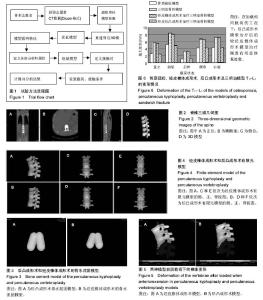| [1] Galibert P, Deramond H, Rosat P, et al. Preliminary note on the treatment of vertebral angioma by percutaneous acrylic vertebroplasty. Neuro-Chirurgie.1987; 33(2):166-168.[2] 董继胜,董力军,闫兵勇,等. 经皮椎体成形术和经皮椎体后凸成形术治疗老年骨质疏松椎体压缩性骨折的疗效观察[J]. 中国矫形外科杂志, 2015,23(8):748-751.[3] 汤建华,李祥,张世华. 经皮椎体成形术和经皮椎体后凸成形术治疗骨质疏松性椎体压缩骨折[J]. 中国伤残医学,2015,6(6): 41-42.[4] 杨惠林, Hansen A.Yuan, 陆俭,等. 球囊扩张椎体后凸成形术治疗骨质疏松性椎体压缩骨折[J]. 苏州大学学报:医学版, 2002, 22(4):406-409.[5] 毛海青,杨惠林,陈亮,等. 磷酸钙灌注椎体后凸成形术的生物力学研究[J]. 苏州大学学报:医学版, 2007,27(1):17-20.[6] 粟迎春. 经皮椎体成形术和经皮椎体后凸成形术治疗骨质疏松性椎体压缩骨折的疗效[J]. 实用医学杂志, 2017, 40(2):74-75.[7] 张大鹏,强晓军,王振江,等. 高黏度骨水泥椎体成形术与低黏度骨水泥椎体后凸成形术治疗骨质疏松性胸腰椎压缩骨折疗效分析[J]. 中国矫形外科杂志,2016,24(4):289-294.[8] 潘爱星,杨晋才,海涌,等. 单侧与双侧穿刺经皮椎体后凸成形术治疗骨质疏松性椎体压缩骨折的对比研究[J]. 中国骨与关节杂志,2016,5(1):44-47.[9] 林金丁,郑毓嵩. 经皮椎体成形术与经皮后凸成形术治疗椎体骨折疗效比较[J].福建医药杂志,2015,37(2):45-48.[10] 董继胜,董力军,闫兵勇,等. 经皮椎体成形术和经皮椎体后凸成形术治疗老年骨质疏松椎体压缩性骨折的疗效观察[J]. 中国矫形外科杂志, 2015,23(8):748-751.[11] 汤建华,李祥,张世华. 经皮椎体成形术和经皮椎体后凸成形术治疗骨质疏松性椎体压缩骨折[J].中国伤残医学, 2015, 6(6): 41-42.[12] 张亮,王静成,冯新民,等.唑来膦酸在骨质疏松性椎体压缩骨折椎体后凸成形术后的应用[J]. 实用医学杂志, 2015, 31(2): 283-285.[13] 崔冠宇,田伟,刘波,等. 椎体强化后椎弓根螺钉内固定术治疗骨质疏松性胸腰椎爆裂骨折[J].中华创伤骨科杂志, 2015,17(6): 502-508.[14] Hierholzer J, Fuchs H, Westphalen K, et al. Incidence of symptomatic vertebral fractures in patients after percutaneous vertebroplasty. Cardiovasc Intervent Radiol. 2008;31(6):1178-1183.[15] Pitton MB,Herber S,Bletz C,et al.CT-guided vertebroplasty in osteoprotic vertebral fractures: incidence of secondary fractures and impact of intradiscal cement leakages during follow-up.Eur Radiol.2008;18(1):43-50.[16] 汪李军,杨惠林,罗宗平,等.椎体强化术后夹心椎体骨折的相关因素分析[J].中华创伤骨科杂志,2011,13(10):911-915.[17] Bliemel C,Oberkircher L,Buecking B,et al.Higher incidence of new vertebral fractures following percutaneous vertebroplasty and kyphoplasty--fact or fiction.Acta Orthopaedica Belgica. 2012;78(2):220-229.[18] Mudano A, Bian J,Cope JJ,et al.Vertebroplasty and kyphoplasty are associated with an increased risk of secondary vertebral compression fractures: a population- based cohort study. Osteoporos Int. 2009;20(5): 819-826.[19] Papanastassiou ID, Phillips FM, Meirhaeghe JV, et al. Comparing effects of kyphoplasty, vertebroplasty, and non-surgical management in a systematic review of randomized and non-randomized controlled studies. Eur Spine J.2012;21(9):1826-1843.[20] Movrin I. Adjacent level fracture after osteoporotic vertebral compression fracture: a nonrandomized prospective study comparing balloon kyphoplasty with conservative therapy. Wiener klinische Wochenschrift, 2012; 124(9):304-311.[21] Zhao Y, Robson Brown KA,Jin ZM,et al.Trabecular level analysis of bone cement augmentation: a comparative experimental and finite element study. Ann Biomed Eng. 2012;40(10): 2168-2176. [22] Mirzaei M,Zeinali A,Razmjoo A,et al. On prediction of the strength levels and failure patterns of human vertebrae using quantitative computed tomography (QCT)-based finite element method. Biomech.2009; 42(11):1584-1591. [23] Wijayathunga VN,Jones AC,Oakland RJ,et al.Development of specimen-specific finite element models of human vertebrae for the analysis of vertebroplasty. Proc Inst Mech Eng H.2008; 222(2):221-228. [24] Zhao Y, Robson Brown K A Jin Z M Wilcox R K. Trabecular level analysis of bone cement augmentation: a comparative experimental and finite element study.Ann Biomed Eng.2012; 40(10): 2168-2176. [25] Chae SW,Kang HD,Lee MK,et al.The effect of vertebral material description during vertebroplasty.Proc Inst Mech Eng H.2010;224(1):87-95. [26] Movrin I, Vengust R, Komadina R.Adjacent vertebral fractures after percutaneous vertebral augmentation of osteoporotic vertebral compression fracture: a comparison of balloon kyphoplasty and vertebroplasty. Arch Orthop Trauma Surg. 2010;130(9):1157-1166.[27] Bliemel C, Oberkircher L, Buecking B, et al. Higher incidence of new vertebral fractures following percutaneous vertebroplasty and kyphoplasty--fact or fiction? Acta Orthopaedica Belgica. 2012;78(2):220.[28] Wang H, Sribastav S S, Ye F, et al. Comparison of percutaneous vertebroplasty and balloon kyphoplasty for the treatment of single level vertebral compression fractures: a meta-analysis of the literature. Pain Physician. 2015;18(3): 209.[29] Klazen CA,Venmans A,De VJ,et al.Percutaneous vertebroplasty is not a risk factor for new osteoporotic compression fractures: results from VERTOS II.Ajnr Am J Neuroradiol.2010; 31(8):1447-1450.[30] Papanastassiou ID,Phillips FM,Meirhaeghe JV,et al. Comparing effects of kyphoplasty, vertebroplasty, and non-surgical management in a systematic review of randomized and non-randomized controlled studies. Eur Spine J.2012;21(9):1826-18 43.[31] Sun K, Liebschner MA. Evolution of vertebroplasty: a biomechanical perspective. Ann Biomed Eng. 2004;32(1):77-91. |

